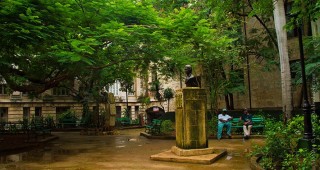One mid-eighteenth century day in London, the Venetian painter Canaletto found himself a bit strapped for cash and decided that drastic measures had to be taken. Whipping out a handy blade, he sliced in half a rather long landscape he’d painted, to sell both halves separately. Now one half of Chelsea from the Thames hangs in Blickling Hall in Norfolk. The other half is in Havana in the Museo de Bellas Artes.
Both the Cuban and the International collections should be high on the list for any visitor even remotely interested in art and culture. The Cuban collection clearly shows the development of painting in the island. There is a small exhibition of charming colonial portraiture including several works by Vicente Escobar (1762-1834), a mulatto painter who despite being appointed court painter to Fernando VII felt it necessary, in the racist climate of nineteenth century Cuba, to take advantage of a loophole in Spanish law to purchase a legal declaration stating that he was white. Works by Juan Bautista Vermay, renowned painter of the famous triptych in El Templete in the Plaza de Armas and founder of the San Alejandro Academy, also hang in this section. An excellent overview of Cuban nineteenth- and twentieth- century painting (don’t miss Amelia Peláez, Portocarrero and Lam) culminates in some of the best of Cuban contemporary work, with regularly changing temporary exhibitions.
A combination ticket may be bought in either of Bellas Artes’ buildings, allowing visits to both, not necessarily on the same day, for a total of 8 CUC. You’ll have to be feeling pretty energetic to take it all in properly in one day—we’d advise dividing your visit, as both collections are rich and varied and are worthy of serious study.
If Arte Cubano is excellent, Arte Universal is breathtaking for the breadth of the collection and the extraordinary building in which it is housed. One-upmanship amongst rich representatives of the various Spanish provinces was the order of the day in nineteenth and early twentieth century Havana. Bellas Artes’ International collection is hung on what used to be the Centro Asturiano, a towering neoclassical edifice overlooking Parque Central and the Gran Teatro de La Habana, which was in its turn developed and embellished by the Galician Club. One imagines the Asturianos and the Gallegos glowering at each other across the square as they plotted their next socially competitive move. The monumental effect of the Arte Universal facade was dramatically complemented and highlighted last year by the placing in front of it of Louise Bourgeois’s traffic-stopping spiders, probably the most successful and remarked-upon public art seen in Havana since the installation of the Fountain of the Indian aka Noble Habana.
Once you’ve stopped gasping at the staggering staircase swooping up from the central atrium of Arte Universal, have a good look round. Particularly recommended are the English and Italian galleries; in the latter hangs perhaps our favourite painting in the entire collection: a fabulous swagger portrait of the Marquesa de Pinar del Río in a drop-waisted flapper dress, with a huge fan and an even huger sense of style. And in the former, glowing gloriously yet somewhat incongruously in its Habanero setting is Canaletto’s depiction of Chelsea Hospital. Sadly the two halves of the painting cannot be exhibited together abroad, as an American foundation has declared its intention of pouncing on the Cuban part if it ever leaves the island. It is to be hoped that in this, as in so many other areas of Cuban-American relations, a sensible, creative and above all an un-hysterical resolution may one day be reached.





 Art Deco
Art Deco





